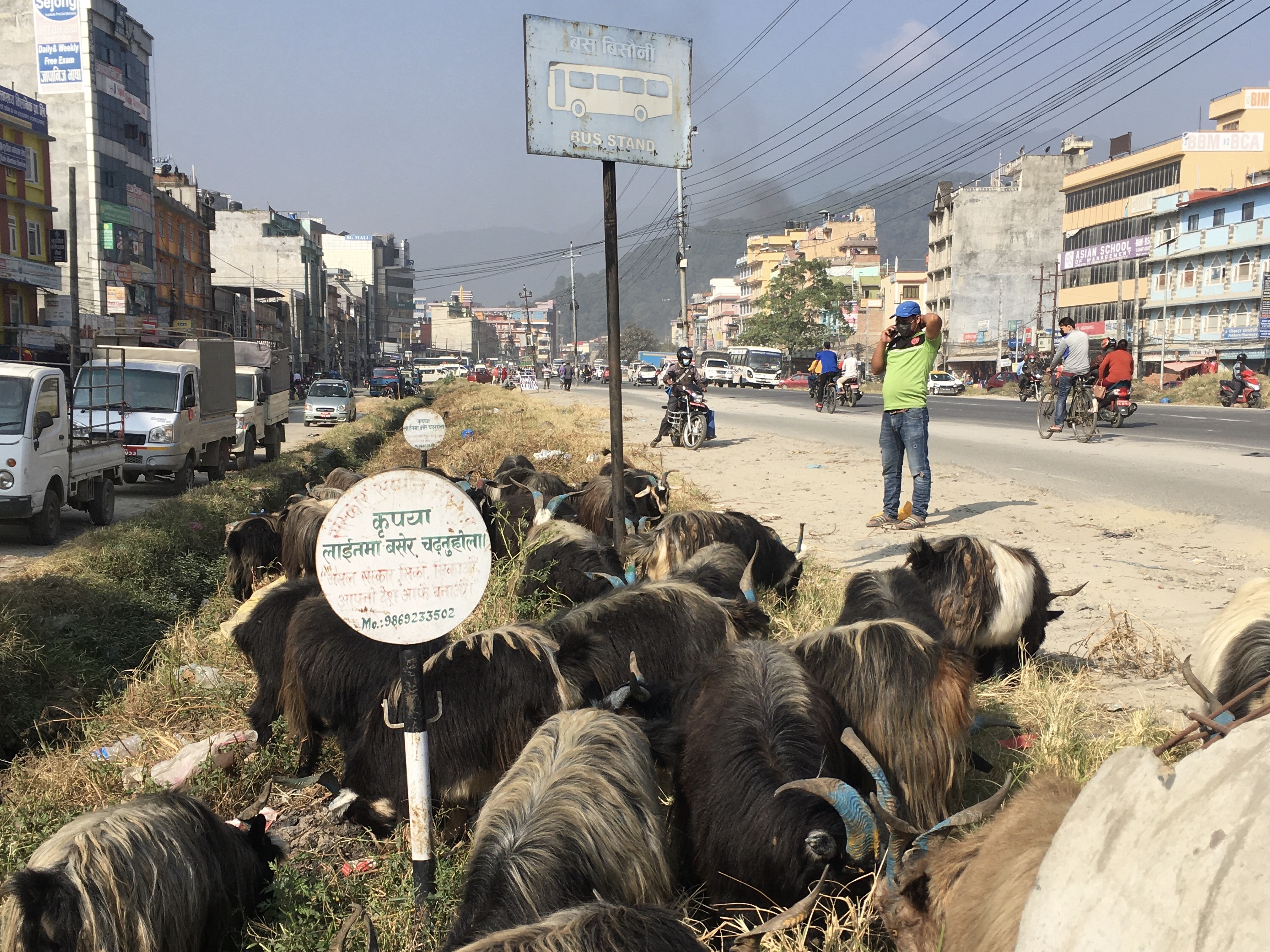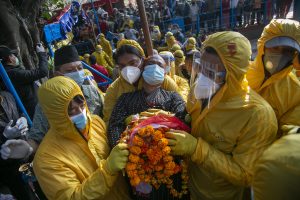On October 22, Prakash Malla, wearing a baseball cap and face mask, stood on the shoulder of Kathmandu’s Ring Road as a group of long-haired mountain goats rooted around in a nearby patch of grass. Malla had brought the goats from Mustang District, in Nepal’s western mountains, to the capital to sell during Dashain, Nepal’s largest Hindu festival, when many families feast on goat meat. The mountain-raised goats are said to have a better flavor than those from the Kathmandu Valley and in a normal year, they would sell out quickly. But this is not a normal year.
“I’ve only sold 11 out of 40 so far,” Malla lamented. “At this rate, I’m not sure if I’ll make it home to my village to celebrate with my family.”
Dashain, which lasted from October 17-27 this year, celebrates the victory of goddess Durga over the evil buffalo-demon Mahishasura. The festival often features the best weather of the year, as monsoon clouds have faded to reveal crystal blue skies. Many Nepalis return to their childhood homes to visit family and friends, gamble, sing, and feast on meat and alcohol. Bamboo swing sets are constructed on ridges and children fly kites from rooftops. As much as it is a religious festival, Dashain is a state of mind: it is a time to forget about one’s worries and to ignore, for a moment, the many uncertainties of everyday life in Nepal — a country that, over the past two decades, has experienced a civil war, devastating earthquakes, and political turmoil surrounding a controversial new constitution.
This year, the coronavirus has taken a heavy toll on the health and wealth of many Nepalis, especially in Kathmandu Valley, where cases are concentrated. Shoppers have less money to spend, and for health reasons, many people are not celebrating the holiday with friends or extended family. In many neighborhoods of the city, a collective uneasiness hangs in the air, which even Dashain festivities can’t seem to cover up.
“There’s no real peace of mind this Dashain,” says epidemiologist Dr. Biraj Karmacharya, who is visiting his parents over the holiday for the first time in months. As director of Public Health and Community Programs at Kathmandu University Hospital in Dhulikhel, Karmcaharya oversees 18 community health centers in collaboration with local government authorities. He says he’s worried that social gatherings for Dashain could become super-spreader events this year.
To date, it has been difficult to predict the course of the pandemic in Nepal. The country recorded just a handful of cases until mid-May, when other South Asian neighbors had tens of thousands. After a small spike in June, the number of infections has been growing steadily since late July, reaching over 158,000 today, with new infections outpacing Bangladesh, Pakistan, and Sri Lanka every day in October. Recently, the Health Ministry projected a “worst case scenario” of 320,000 cases over the next four months — a prediction that some experts believe is too rosy.
Although the fatality rate remains low — around 0.5 percent — Karmacharya worries that that deaths could climb if the pandemic’s epicenter shifts from Kathmandu to rural areas as people travel from the city to their villages for Dashain. As in India, which recently experienced a “rural surge,” health care and transportation infrastructure are limited in much of rural Nepal, making care for COVID-19 patients extremely difficult.
The government had been providing free COVID-19 testing and treatment at government hospitals until mid-October, when it announced that most citizens would have to pay for these services. But even before this announcement, many Nepalis relied on private hospitals because the government health care system is overcrowded and understaffed, with health care workers recently staging protests to get basic PPE. There have been sporadic reports of shortages of ventilators and ICU beds in Kathmandu, and in many rural parts of the country, such facilities remain too far away to access.

Prakash Malla and his goats alongside the Ring Road in Kathmandu. Photo by Peter Gill
Just outside Kathkmandu’s Gongabu Bus Park, Kharka Maya Dahal, a mother of four, sits at the counter of her shop, surrounded by glass display cases of watches and sunglasses, a glum look on her face. Business has been slow, and Dahal says she is seven months behind in rent.
“We can’t celebrate Dashain this year,” she says. “If my landlord learned I ate goat meat during Dashain, he’d force me to pay rent. Dashain this year is only for rich people, not people like me.”
For many businesses, the government’s unpredictable and ad-hoc response to the pandemic has made planning difficult. The government forced most businesses to close in late March, when there were fewer than a dozen cases. The lockdown lasted nearly four months, until mid-July. In September, the Health Ministry indicated that a lockdown might be reimposed if active cases crossed 25,000, but no such decision was ever made; there are currently over 45,000 active cases. Agencies like the Health Ministry, the Home Ministry, and the COVID-19 Crisis Management Center – a politically appointed oversight body – vie for control over decisions and resources, leading to confusing and sometimes conflicting policies.
From a macroeconomic viewpoint, Nepal remains in a precarious situation. GDP grew by only 0.2 percent in the fiscal year ending in July. Consumer spending is low, and despite promises to provide greater employment opportunities through a special Prime Minister’s Employment Program, spending on government projects has been slow. State revenue is way down, in part because the government relies heavily on taxes on imports, which have seen a marked decline since the pandemic began.
One of the few economic bright spots has been remittances that millions of Nepali workers continue to send home from the Middle East, Malaysia, and elsewhere. Migration has long been a lifeline for Nepal’s economy, but early in the pandemic, hundreds of thousands of Nepalis lost jobs abroad. Many returned overland from India, and after the international airport opened for chartered flights in June, over 110,000 have returned from other countries. Nonetheless, fewer overseas jobs were lost than expected, in part because Middle East economies recovered quickly after a sharp fall in oil prices in April. Official data indicate that remittances to Nepal have remained strong over the past four months. While the data do not reflect the use of informal money transfer systems — which were common before the pandemic and may have declined — Nepal’s remittance income has defied many observers’ worst fears.
On Saturday, around 40 men lined up outside Mahalaxmisthan Temple in Lagankhel neighborhood to receive a serving of rice and chicken curry in daily event organized by Hiteri, a Nepali crowdfunding platform. Some of the men wore ripped clothing and had long, matted hair, but others had the look of the newly homeless. One man in his 30s, who gave his name only as Bikash, said that he had returned to Nepal earlier this year after working on an oil palm plantation in Malaysia. He initially returned to his village in Ramechhap District in the east, but after running out of savings he came to Kathmandu three months ago to work as a daily laborer in construction.
Asked about his plans for after Dashain, Bikash said: “Who knows? I take it day by day.”
Many political commentators have criticized Nepal’s top leaders for failing to pay attention to the needs of ordinary citizens like Bikash, and instead engaging in unwarranted political battles. Since May, when leaders came together to denounce India’s construction of a new road in the disputed Lipulekh region along the border with Nepal, leaders within the ruling Nepal Communist Party (NCP) have engaged in an internecine power struggle. The dispute, between one faction led by Prime Minister Khadga Prasad Sharma Oli and another led by his party’s co-chair, Pushpa Kamal Dahal, has led to several cabinet reconfigurations and tussles at the provincial assembly level. At one point in July, the Chinese ambassador seemed to broker a temporary peace. Last week, the head of the Indian spy agency the Research and Intelligence Wing held a meeting with Oli in Kathmandu, leading to speculation about how India is trying to steer the NCP dispute. Combined with reports of high-level corruption in the procurement of COVID-related health supplies, NCP leaders’ focus on internal power struggles have given many citizens affected by COVID-19 the impression that the government’s priorities lie elsewhere.
Amidst great uncertainty, many people turn to familiar sources for direction.
On Friday, Binod Bajracharya, a traditional Newar astrologer, sat on the floor in his office in the Sundhara neighborhood, his back against a wall decorated with tanka paintings of bodhisatvas. The soothsayer’s phone had been ringing off the hook all morning.
“In normal times, people call me to ask for readings for their newborns, or to see if a marriage proposal is a good match. But these days, many people are calling with financial or health-related questions,” Bajracharya said. “Some people ask which hospital to go to, or whether they should close their business, move it online, or take out a loan. There are many difficult choices.”

































